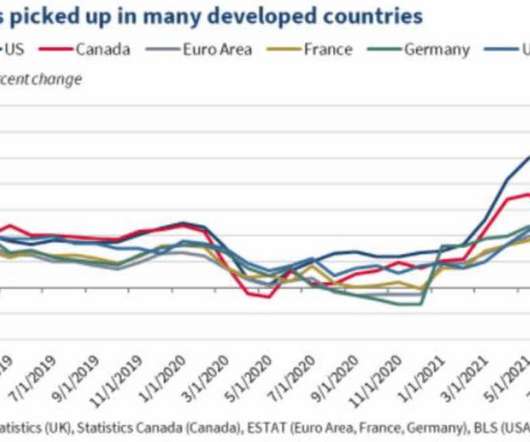Spotlight on Apparel: What’s Going On
MishTalk
OCTOBER 8, 2016
Unlike gasoline, housing, food, and auto loans, apparel is a discretionary purchase. What are consumers and importers doing? more…).
This site uses cookies to improve your experience. By viewing our content, you are accepting the use of cookies. To help us insure we adhere to various privacy regulations, please select your country/region of residence. If you do not select a country we will assume you are from the United States. View our privacy policy and terms of use.
 Apparel Related Topics
Apparel Related Topics 
MishTalk
OCTOBER 8, 2016
Unlike gasoline, housing, food, and auto loans, apparel is a discretionary purchase. What are consumers and importers doing? more…).

Harvard Business
SEPTEMBER 25, 2023
In the apparel sector, for example, buyers must place peak-season orders six months in advance. And as we emerged from the pandemic, many companies overcorrected by adopting “just-in-case inventory management.” With high volatility, demand forecasts in June can be completely different than actual demand in December.
This site is protected by reCAPTCHA and the Google Privacy Policy and Terms of Service apply.

Brimstone Consulting
JANUARY 13, 2023
Several states have begun to ban the use of PFAS and have put in place regulations that are disrupting product development, product selection, and corporate strategy for food brands, major retailers, toy manufacturers, automotive manufacturers, apparel and footwear companies, and many others. If not, should it?

BCG
DECEMBER 13, 2016
Article Tuesday, December 13, 2016. In the wake of the recent financial crisis, the global fashion and luxury industry established a solid record of extremely strong value creation. More recently, however, the industry’s performance declined somewhat—a trend that has continued into 2016.

On the Brink Podcast
APRIL 12, 2021
As a fashion designer and owner of her own apparel sales firm, Babette had to constantly re-invent herself, learn how to run a business, and deal with the challenges of sustaining successful partnerships with men. Babette Ballinger holds a special place in our hearts, and in my new book, " Rethink: Smashing the Myths of Women in Business. "

Successful Independent Consulting
JULY 21, 2018
For example, an organizational change consultant hired to provide consulting services to an apparel company would probably satisfy this part of the test even if the apparel company had an organizational effectiveness department because the company’s primary business is apparel, not organizational change services.

Tom Spencer
JUNE 6, 2020
Think about apparel products: in many countries, stores are still the primary place to buy clothes whereas in China, physical stores are in decline in favour of e-commerce. Due to the boom of the internet, nearly one third of apparel and footwear was sold online in 2018 (vs 1% in 2010). Psychographic segmentation.

Strategy+Business
JUNE 7, 2017
The founder of the apparel company talks about how much personal growth leaders should demand -- of employees and themselves.

Strategy+Business
OCTOBER 9, 2018
Think high-profile consumer goods, and sports apparel comes quickly to mind. For the last few years, the world's fastest-growing major sports apparel enterprise has been Adidas. The CEO overseeing Adidas's flourishing is Kasper Rørsted, a man who spent the first half of his career in the tech industry.

MishTalk
AUGUST 12, 2016
Economists were shocked once again today. First, Retail Sales “Solidly” Flat, which we just covered. The Producer Price Index for … Continue reading →

Women in Consulting
JULY 13, 2018
For example, an organizational change consultant hired to provide consulting services to an apparel company would probably satisfy this part of the test even if the apparel company had an organizational effectiveness department because the company’s primary business is apparel, not organizational change services.

Strategy+Business
JUNE 7, 2017
Yes, according to the apparel company CEO. Is it fair to ask employees to embrace personal growth, on top of everything else they do? See also "Eileen Fisher on Leadership: The Personal Side of Organizational Change."

Martinka Consulting
APRIL 21, 2021
The ruling was against the former board members of the Jones Group, an ownership group of apparel brands including Gloria Vanderbilt, Anne Klein and Nine West. The New York Times reported on a “little-noticed court ruling in December (2020).” In 2014 the Jones Group sold to Sycamore Partners in a highly (one might say overly) leveraged deal.

MishTalk
AUGUST 11, 2017
The CPI rose 0.1% in July vs an Econoday consensus estimate of 0.2%. The Econoday Keynesian parrot does not like falling auto prices but is happy about rising medical prices. more…).

MishTalk
APRIL 17, 2016
“Exodus Has Begun” The minimum wage hike is about to smack Los Angeles’ apparel industry businesses and jobs. The LA … Continue reading →

Harvard Business
JULY 13, 2017
Phil Knight, former chair and CEO of Nike, tells the story of starting the sports apparel and equipment giant after taking an entrepreneurship class at Stanford and teaming up with his former track coach, Bill Bowerman. Together (and with the help of a waffle iron) they changed how running shoes are designed and made.

Kai Davis
APRIL 24, 2020
Like ‘Veterinary Clinics’ or ‘Accountants’ or ‘Direct To Consumer Apparel Stores on Shopify.’. That means you want to move away from niches like ‘Small Business’ and move towards niches that are targeted and specific. When I’m evaluating a niche, I approach it with a few questions.

Kai Davis
MAY 30, 2020
Like ‘Veterinary Clinics’ or ‘Accountants’ or ‘Direct To Consumer Apparel Stores on Shopify.’ That means you want to move away from niches like ‘Small Business’ and move towards niches that are targeted and specific. ’ When I’m evaluating a niche, I approach it with a few questions.

1 to 1
JULY 29, 2022
Apparel companies Stitch Fix and ThirdLove are two examples of companies that tout their use of data analytics and artificial intelligence in their services. “Businesses can capture a wider range of audiences if they work on putting a more personal touch side by side with automation and predictive analytics today,” Lee says.

Harvard Business
MAY 26, 2016
To examine this possibility, I conducted research on recent developments in Nike Inc’s apparel supply chain with Jens Hainmueller of Stanford University and Richard M. In the mid-2000s, Nike embarked on a program to introduce lean manufacturing to its apparel suppliers in the developing world. Locke of Brown University.

Harvard Business
AUGUST 4, 2017
The accessories and apparel designer uses in-store radio-frequency identification to send clothing items to dressing rooms, helps customers choose different styles and sizes, and shows stock availability in stores and online. But brick-and-mortar retail doors are closing, especially for apparel, as shoppers take their business online.

1 to 1
JANUARY 19, 2017
Squeezed by online competitors and evolving customer tastes, Macy’s, Sears, The Limited, and American Apparel have said they will be closing some or all of their stores. Several large retail brands kicked off 2017 with announcements that they were laying off employees or closing altogether.

1 to 1
SEPTEMBER 7, 2016
On Tuesday, Google introduced a “Shop the Look” program that lets smartphone users purchase apparel and other products through the images that appear in response to search terms. Earlier this week, Google unveiled its latest effort to help retailers boost sales through mobile devices.

MishTalk
JANUARY 15, 2016
Apparel was a standout, down 0.9%. The Beige Book yesterday warned us about weak apparel sales which in this report fell a very steep 0.9 Despite glowing reports of last minute Christmas sales, none of which I believed, December retail sales are best described as awful. The surprise here is that nobody blamed the weather.

Harvard Business
MARCH 21, 2018
Instead of thinking of itself merely as a sports apparel manufacturer, the company has purposefully developed a “connected fitness” ecosystem. Under Armour intends to enable these platforms to grow independently, while reaping aggregated data that can inform and expand its apparel designs. Under Armour, Inc.

Harvard Business
JULY 8, 2016
The American textile and apparel industries, for example, will tell you that the evidence can be found in the blood on the floor — their blood, on what used to be their floor. Experts continue to debate whether Chinese businesses are truly disruptive. For some industries in the West, this question appears a bit ridiculous.

1 to 1
JANUARY 12, 2015
Among the closings are Macy''s, JCPenney, Guess, Radio Shack, as well as teen apparel stores Delia''s, Aeropostale, Wet Seal, and Abercrombie & Fitch. With the holiday shopping season behind us, retailers have planned a tidal wave of store closings for 2015. There’s more… To read the rest of this blog posting click here or visit www.1to1Media.com/weblog.

MishTalk
NOVEMBER 10, 2015
Inventory draws reflecting gains in sales include computer equipment, electrical goods, and apparel. Inventories of autos rose 2.3 percent as wholesalers try to keep up with what is very strong retail demand for autos. Excluding autos, the stock-to-sales wholesale ratio is unchanged at 1.27.

Management Consulted
JANUARY 22, 2017
Whether someone is out shopping for apparel or looking to better our world, TOMS gives an opportunity for both. Today we highlight tremendous business analyst and post-consulting leadership jobs at TOMS. TOMS is a popular shoe manufacturer known for combining philanthropy with a profitable business model.

MishTalk
AUGUST 27, 2013
Indian shoppers are not only cutting back on big-ticket purchases such as refrigerators, TVs or expensive branded apparel but even staples including soaps, ketchup and cosmetics. Bhatia, head of the enterprise business at television maker Videocon Industries, said in an August 21 interview.

Tom Spencer
NOVEMBER 27, 2021
apparel and electronics), but the price of other consumer goods have risen sharply (e.g., The CPI is an aggregate measure of the price level, which means that different consumers will face different rates of inflation depending on which goods they choose to buy. Figure 2 : Inflation Adjusted Price Changes since 1998.

Harvard Business
NOVEMBER 22, 2017
For a sports apparel and equipment maker, for instance, the generic “improve collaboration across different categories” contains less useful direction than “make it easy for us to deliver coordinated head-to-toe apparel and footwear to stores in time for the season.”

MishTalk
NOVEMBER 24, 2015
Appliances, entertainment items, infant products and hardware showed narrowing discounts, MarketTrak reported, while promotions for apparel, toys and electronics were getting bigger. Kurt Jetta, head of retail industry researcher TABS Group, found the discounts underwhelming.

Harvard Business
MAY 15, 2018
Nike, once an athletic apparel brand telling stories of athletic solo willpower, has now taken on a systemic nature by introducing brand experiences , such as Nike Plus, Nike Plus Training Club, Nike Plus Running Club, etc. In other words, the brand becomes the customer experience and the customer experience becomes the brand.

Harvard Business
JUNE 7, 2016
Some retailers and manufacturers—in the apparel, footwear, and electronics industries—have launched programs to make their customers interested in preserving their products and preventing things that still have value from going to the landfill.

MishTalk
NOVEMBER 13, 2015
Apparel sales, which are definitely being held down by import prices, were unchanged following two small declines. Declines in the latter may be related to import-price effects which are deflating sales. A positive, however, is a gain for department stores which are a subset of general merchandise.

MishTalk
DECEMBER 9, 2015
Inventory draws reflecting rising sales include furniture, apparel, and farm products. Inventory builds reflecting falling sales include metals and autos, though strong sales of the latter at the retail level point to a bounce back for related wholesale sales.

MishTalk
AUGUST 19, 2015
Another major component showing upward pressure in July is apparel which rose 0.3 But with gas prices moving steadily lower this month, the upward effects of gasoline will be turning downward in August. percent following, however, a long string of declines. Owners equivalent rent continues to show pressure, up 0.3 percent.

MishTalk
JUNE 18, 2015
Components of note include a second month of declines for apparel, down 0.5 This is down from 1.8 percent in April but is still skating a bit close to the 2.0 percent hawk barrier at the Fed. The overall year-on-year rate, however, is as benign as can be at zero percent. percent in May after falling 0.3 Showing pressure is a 2.7

Harvard Business
NOVEMBER 21, 2016
The company offers a subscription clothing and styling service that delivers apparel to its customers’ doors. A five-year-old online clothing retailer, its success in this area reveals how AI and people can work together, with each side focused on its unique strengths. This is where the work interface comes into effect.

Harvard Business
SEPTEMBER 14, 2017
In the apparel sector, for instance, the unusually warm winter temperatures across Europe and the U.S. last year triggered shortfalls in sales, store closures, and job cuts. In the UK, no less than 18 weather-related profit warnings were issued by industry leaders.

Kates Kesler
JANUARY 25, 2013
Take Nike, marketing a core brand across a number of consumer categories with hundreds of footwear and apparel products all over the world. When there is no tension among businesses and functions and geographies there’s a good chance value is being left on the table somewhere. Nike’s money-making matrix.

Harvard Business
APRIL 25, 2017
It’s an apparel manufacturer called 99Degrees Custom. Now in its second year, it distributes cash prizes to inspiring organizations who “are using technology to reinvent work and create economic opportunity for people below the top rung of the economic ladder.”

Harvard Business
AUGUST 3, 2017
” Life Is Good is an apparel company best known for colorful T-shirts with stick-figure designs, but its mission is to spread optimism and hope throughout the world, and that’s something that even warehouse employees understand. There’s a great story about a janitor that John F. Kennedy ran into at NASA in 1962.
Expert insights. Personalized for you.
We have resent the email to
Are you sure you want to cancel your subscriptions?

Let's personalize your content